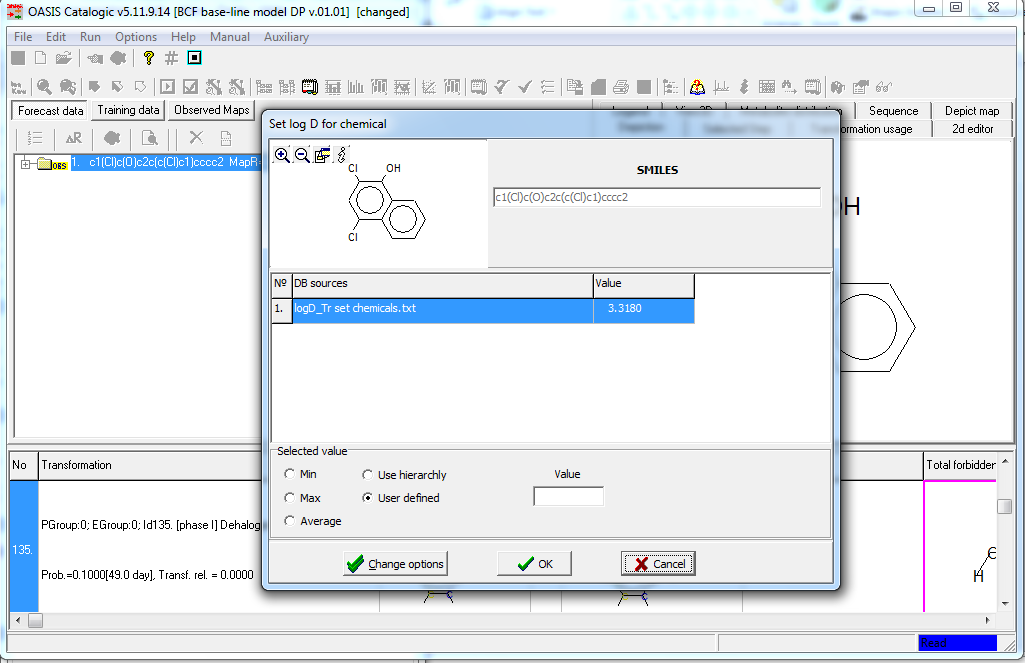BCF base-line model D/P
Endpoint
The BCF base-line model D/P predicts bioconcentration factor (BCF, l/kg wet) in fish. Model accounts for a number of mitigating factors, such as molecular size, metabolism of parent chemical, water solubility and ionization. The effect of ionization on the bioaccumulation potential was assessed on the basis of distribution coefficients (log D) and partitioning coefficients (log P) of chemicals.
Data
The model is derived for the same training set as the BCF base-line model. The training set of the model consists of 697 chemicals. The following chemical databases were used:
- Biodegradation and Bioaccumulation Data of Existing Chemicals Based on the CSCL Japan (MITI database) [1],
- Chemicals tested by National Institute of Technology and Evaluation of Japan (NITE) using the same fish (Cyprinos carpio) [2],
- 145 BCF values extrapolated from dietary bioaccumulation experiments with salmonids [3].
The MITI BCF data and the data provided by NITE derived at the lowest concentration exposure have been used in model development. The basic requirements for the experimental data were that they meet the OECD 305 protocol criteria and that the experimental BCF data were generated based on the concentration of the parent chemicals only and not on the total amount of parent and metabolites (e.g., the total radioactivity).
Distribution coefficients (log D) and partitioning coefficients (log P) were used to assess the effect of ionization on the bioaccumulation potential of chemicals. Calculation of pKaand log D for the training set chemicals was carried out using ACDLABS 12.0 [4]. Chemicals for which log D cannot be calculated were excluded from the training set.
Another training database of documented fish and rat liver transformation maps for 433 organic compounds and expert knowledge was used to determine the principal transformations and to train the system to simulate the fish liver metabolism of training chemicals. The documented pathways were collected from scientific papers, monographs and databases accessible over the Internet.
Model
The BCF base-line model is based on the assumption of a maximum biocencentration factor (log BCFMAX) and mitigating factors contibuting to the reduction of the maximum BCF value:
![]()
where Fi model the mitigating effect of metabolism, ionization and molecular size and FWS that of water solubility [5, 6].
A re-formulation of the ionization term, motivated by the need to advance bioaccumulation modeling of ionizable compounds, was introduced. The ratio of the distribution and partition coefficients of the training set chemicals was selected as a term describing the relative reduction in lipophilicity of a chemical as a result of ionization. Model parameters were re-evaluated for the new model formulation.
Domain
The applicability domain of the model [7] consists of the following sub-domain levels:
- General parametric requirements - includes ranges of variation of log KOW and MW,
- Structural domain - based on atom-centered fragments (ACFs),
- Mechanistic domain - identifies the mechanism of bioaccumulation of chemicals.
A chemical is considered In Domain if its log KOW and MW are within the specified ranges, its ACFs are presented in the training chemicals and its mechanism of bioaccumulation is passive diffusion. The information implemented in the applicability domain is extracted from the correctly predicted training chemicals used to build the model and in this respect, the applicability domain determines practically the interpolation space of the model.
Performance
Goodness of fit evaluated by the coefficient of correlation is R = 0.93
Reporting
The model provides results for:
- log BCF of organic chemicals corrected with mitigating factors, (l/kg wet-wt),
- log BCFMAX ,
- Range of variation of maximum diameter for energetically stable conformers,
- Whole body primary biotransformation half-lives (HL) for organic chemicals in fish, days,
- Metabolic biotransformation rate constant KM, day-1,
- Effect of mitigating factors,
- Applicability domain.
References
1. Chemicals Inspection and Testing Institute, Biodegradation
and Bioaccumulation data of existing chemicals based on the CSCL
Japan, Chemical Industry Ecology-Toxicology & Information
Center, Japan, 1992, ISBN 4-98074-101-1.
2. NITE, Biodegradation and Bioconcentration of the Existing
Chemical Substances under the Chemical Substances Control Law, http://www.safe.nite.go.jp/english/db.html
3. T. Parkerton. Phase II Report. The bioaccumulation of petroleum
substances and their constituent hydrocarbons on the Canadian
Designated Substances List (DSL), Exxon Mobil Biomedical Sciences
Inc., 2004.
4. Advanced Chemistry Development 2008. ACD/LogD Solubility Suite,
Version12 Toronto, ON, Canada.
5. S. Dimitrov, N. Dimitrova, T. Parkerton, M. Comber, M. Bonnell,
and O. Mekenyan, SAR QSAR Environ. Res. 6, 2005,531-554.
6. S. Dimitrov, N. Dimitrova, D. Georgieva, K. Vasilev, T.
Hatfield, J. Straka, and O. Mekenyan, SAR QSAR Environ. Res. 23,
2011,17-36
7. S. Dimitrov, G. Dimitrova, T. Pavlov, N. Dimitrova, G.
Patlevisz, J. Niemela and O. Mekenyan, J. Chem. Inf. Model. 45
(2005), pp. 839-849.

